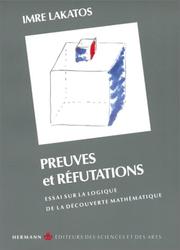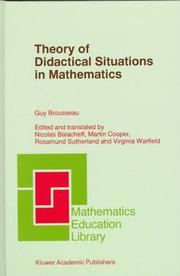| Listing 1 - 4 of 4 |
Sort by
|
Book
ISBN: 9048182085 140209826X 9786612068324 1282068326 1402098278 Year: 2009 Publisher: Dordrecht ; London : Springer,
Abstract | Keywords | Export | Availability | Bookmark
 Loading...
Loading...Choose an application
- Reference Manager
- EndNote
- RefWorks (Direct export to RefWorks)
Technology-enhanced learning is a timely topic, the importance of which is recognized by educational researchers, practitioners, software designers, and policy makers. This volume presents and discusses current trends and issues in technology-enhanced learning from a European research and development perspective. This multifaceted and multidisciplinary topic is considered from four different viewpoints, each of which constitutes a separate section in the book. The sections include general as well as domain-specific principles of learning that have been found to play a significant role in technology-enhanced environments, ways to shape the environment to optimize learners’ interactions and learning, and specific technologies used by the environment to empower learners. An additional section discusses the work presented in the preceding sections from a computer science perspective and an implementation perspective. This book comes out of the work in Kaleidoscope: a European Network of Excellence in which over 1,000 people from more than 90 institutes across Europe participate. Kaleidoscope brings together researchers from diverse disciplines and cultures, through their collaboration and sharing of scientific outcomes, they are helping move the field of technology-enhanced learning forward.
Education --Effect of technological innovations on. --- Educational innovations. --- Educational technology. --- Educational technology --- Educational innovations --- Education --- Theory & Practice of Education --- Social Sciences --- Effect of technological innovations on --- Effect of technological innovations on. --- Innovations, Educational --- Technological change in education --- Instructional technology --- Technology in education --- Innovations --- Technological innovations --- Education. --- Application software. --- Educational Technology. --- Learning & Instruction. --- Computer Appl. in Social and Behavioral Sciences. --- Technology --- Instructional systems --- Teaching --- Aids and devices --- Educational planning --- Educational change --- Experimental methods --- Social sciences --- Data processing. --- Children --- Education, Primitive --- Education of children --- Human resource development --- Instruction --- Pedagogy --- Schooling --- Students --- Youth --- Civilization --- Learning and scholarship --- Mental discipline --- Schools --- Training --- Learning. --- Instruction. --- Application computer programs --- Application computer software --- Applications software --- Apps (Computer software) --- Computer software --- Learning process --- Comprehension

ISBN: 2705614125 9782705614126 Year: 1984 Volume: 1412 Publisher: Paris Hermann
Abstract | Keywords | Export | Availability | Bookmark
 Loading...
Loading...Choose an application
- Reference Manager
- EndNote
- RefWorks (Direct export to RefWorks)
Mathematics --- Logic, Symbolic and mathematical. --- Philosophy. --- 510.21 --- 510.21 General philosophical considerations. Critical aspects. Logical antinomies --- General philosophical considerations. Critical aspects. Logical antinomies --- Logic, Symbolic and mathematical --- Mathématiques --- Logique symbolique et mathématique --- Philosophy --- Philosophie --- Heuristic. --- Heuristique. --- Heuristique --- Mathematics - Philosophy. --- Logique mathematique --- Preuve, theorie de la --- Refutation (logique) --- Theorie de la preuve

ISBN: 9780792345268 0792345266 9786610207619 1280207612 0306472112 Year: 1997 Publisher: Dordrecht Kluwer Academic Publishers
Abstract | Keywords | Export | Availability | Bookmark
 Loading...
Loading...Choose an application
- Reference Manager
- EndNote
- RefWorks (Direct export to RefWorks)
On the occasion of the celebration of “Twenty Years of Didactique of Ma- ematics” in France, Jeremy Kilpatrick commented that though the works of Guy Brousseau are known through texts referring to them or mentioning their existence, the original texts are unknown, or known only with difficulty, in the non-Fren- speaking world. With very few exceptions, what has been available until now have been interpretations of the works of Brousseau rather than the works themselves. It was in response to this need that two of us, in the euphoria of an unforgettable Mexican evening at the time of the 1990 PME conference, decided to undertake the task of translating into English most of the works of Guy Brousseau. The ceuvre is immense, and once past the initial moments ofenthusiasm, with the accompanying ambition to produce the entire of it, we recognized the need to choose both the texts and a method of proceeding. As far as the texts go, we chose to take the period from 1970 to 1990, in the course of which it seemed to us that Brousseau had forged the essentials of the Theory of Didactical Situations. But even there the collection is huge. So, after an initial translation of most of the publications of the period, we carved out a selection, retaining the texts which gave the best presentation of the principles and key concepts of the Theory.
51 --- 51:37 --- 51:37 Mathematics-:-Opvoeding en onderwijs --(algemeen) --- Mathematics-:-Opvoeding en onderwijs --(algemeen) --- 51 Mathematics --- Mathematics --- Math --- Science --- Study and teaching --- Mathematics. --- Mathematics Education. --- Mathematics—Study and teaching . --- 51 Wiskunde. Mathematiek --- Wiskunde. Mathematiek
Book

ISBN: 2271064155 2271128242 Year: 2020 Publisher: Paris : CNRS Éditions,
Abstract | Keywords | Export | Availability | Bookmark
 Loading...
Loading...Choose an application
- Reference Manager
- EndNote
- RefWorks (Direct export to RefWorks)
Depuis 25 ans, les technologies de l’information et de communication ont transformé le monde. En quelques années, le commerce, la finance, les échanges, l’école, le travail, la culture, la politique, etc. se sont totalement modifiés du fait de leur développement. Qu’on se remémore quelques-unes des étapes les plus marquantes de ces évolutions : apparition des mini puis des micro-ordinateurs, nouvelles interfaces avec utilisation de la souris et métaphore du bureau, essor des hypermédia, popularisation du Web, nomadisme généralisé, informatique vestimentaire, intelligence d’ambiance... Les changements ont été imaginés, conçus, développés, expérimentés dans des laboratoires de recherche. Partout, la recherche a pris, et continue de prendre, une part déterminante. Or, il est parfois difficile de discerner ce qui relève de la recherche fondamentale et du travail universitaire, de ce qui correspond à l’innovation industrielle. Qu’est-ce qui distingue la « R. et D. » — la recherche et développement Industriel — de la recherche universitaire ? Quelle part cette dernière prend-elle exactement dans l’innovation ? Quel rôle sera-t-elle amenée à jouer dans les prochaines années ? Telles sont les questions auxquelles nous avons voulu répondre en publiant un ouvrage destiné aux ingénieurs, aux chercheurs, aux décideurs et, plus généralement, à l’honnête homme du début du xxie siècle qui souhaite comprendre le sens des évolutions technologiques actuelles.
Communication --- Information society --- Technologies de l'information et de la communication --- Société informatisée --- Technological innovations --- Research --- Recherche --- User interfaces (Computer systems) --- Technological innovations. --- Interfaces, User (Computer systems) --- Human-machine systems --- Human-computer interaction --- informatique --- information --- modélisation --- web --- internet --- télécommunication --- donnée --- TIC
| Listing 1 - 4 of 4 |
Sort by
|

 Search
Search Feedback
Feedback About UniCat
About UniCat  Help
Help News
News